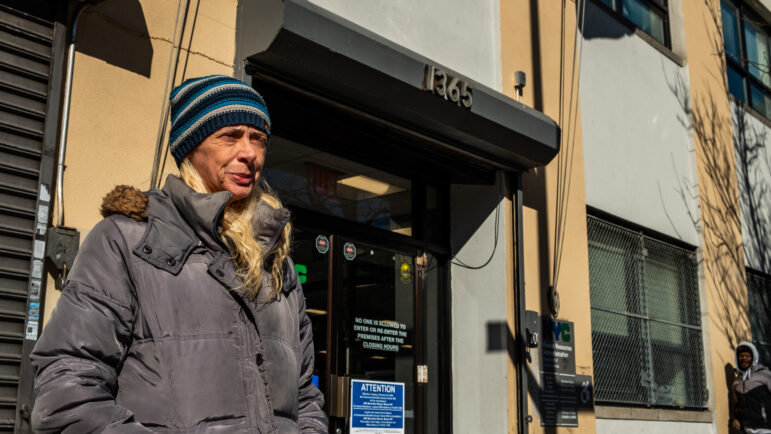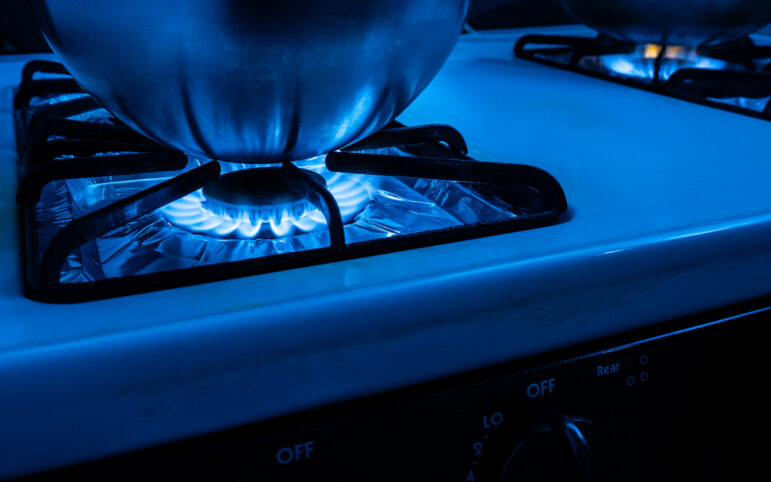Friday marked the final day of operations at 1365 Jerome Ave. in Mount Eden, where Human Resources Administration staff helped New Yorkers apply for food, Medicaid and cash assistance.

Adi Talwar
Tyler London outside HRA’s walk-in benefits center at 1365 Jerome Ave. in the Bronx on its final day of operation.On Friday, Adriano set up his plastic folding table for the last time outside the entrance of a walk-in public benefits center in the Mount Eden section of the Bronx.
Feb. 16 marked the final day of operations at 1365 Jerome Ave., where Human Resources Administration (HRA) staff helped New Yorkers apply for food, Medicaid and cash assistance. As of Tuesday, some of those services have moved to 845 Barretto St. in Hunts Point, several miles southeast and at least 30 minutes by public transit.
Adriano, who declined to provide his last name, issues free cell phones to people who qualify for public benefits. It’s a commission-based gig, and this spot, by an office he’s visited for updates on his own Supplemental Nutrition Assistance Program (SNAP) case, ensured a stream of potential takers.
“It’s going to impact me a lot,” he said of the closure. “[Outside] the other office, they already have people from my company.”
In response to the COVID-19 pandemic, HRA made a major shift to remote processing for public benefits, accepting applications and documents online and conducting all interviews by phone. But New Yorkers told City Limits Friday that they still rely on brick-and-mortar centers like 1365 Jerome Ave., of which there are a few dozen.
The city has not provided details about the closure of this site, which opened in 1987, simply referencing building-related issues. Throughout the morning Friday, people came in and out of the tan, squat building by the elevated MTA station at 170th Street, often holding paperwork. Closure notices were fixed to the doors.
Tyler London was visiting the center with her 1-year-old daughter. She’d come to check on the status of her case after receiving an error message that she feared would suspend her cash support and SNAP, also known as food stamps. “My food being put on hold is a very big problem because I need to feed myself and my kids,” she said.
London explained that she prefers coming to Jerome Avenue when she has questions because it is difficult to get through on HRA’s customer service line, known as InfoLine. At an oversight hearing last fall, Jill Berry, first deputy commissioner at the Department of Social Services, acknowledged that wait times for the phone line are “in the hours.”
“I tried calling the InfoLine number and it’s very hard to get through to anybody,” London said. “And when they told me that they’re going to call me back… they never called me back.”
“I like this center. The people I talk to are very nice,” she added. It’s a 20-minute walk from her home, while Hunts Point will require a longer commute. “My plan is to take a different bus route, and that means I’m going to have to leave earlier because I have a stroller so I don’t like to travel when there’s rush hour,” she said.

Adi Talwar
“It’s going to impact me a lot,” said Adriano, who had a job issuing free cell phones to people who qualify for public benefits outside the Jerome Avenue site.1365 Jerome Ave. included a Benefits Access Center (BAC) and a SNAP Center. The former offered a range of services for very low-income households who qualify for semi-regular payments, including rent support, while the latter served households that only receive SNAP, a program with more generous income qualifications.
Omawattie Jaman, who lives nearby, told City Limits that she visits the center twice a month, and has fond memories of coming with her mom and brothers. “I can’t explain it,” she said. “The city should keep it open. Because this is the best place. Everybody who comes here loves this place.”
By moving to 845 Barretto St., the Jerome Avenue BAC is now sharing an address with a pre-existing SNAP Center. Another BAC is located next door, at 847 Barretto, but the number of SNAP centers in the Bronx has now dwindled from three to two. Citywide there are currently 29 SNAP offices or BACs at 18 locations, as several are colocated.
In a statement, an HRA spokesperson said that the city is strengthening its “highly-effective remote processes in a post-pandemic landscape.” According to the agency, more than 90 percent of SNAP recipients are currently applying online.
“DSS-HRA has greatly strengthened remote access to critical benefits, including SNAP, as more and more New Yorkers prefer to apply online, while also retaining our brick-and-mortar locations… to give applicants the option of walking into sites to apply in person,” the statement read.

Adi Talwar
Outside HRA’s walk-in benefits center at 1365 Jerome Avenue in The Bronx, which closed its doors for the final time on Feb. 16.While each center has a catchment area of specific zip codes, New Yorkers can walk into any center for service regardless of where they live, according to HRA. But this doesn’t always work in practice, according to Adriana Mendoza, benefits supervisor with the Safety Net Project at the Urban Justice Center.
“We’ve heard from our clients that many times people are turned away,” she said. “Staff oftentimes tell them that they have to go to another center.”
The number of New Yorkers receiving benefits has increased year-over-year. There were 495,600 people receiving cash assistance in October 2023, according to HRA, up 13 percent from the year prior. There are about 1.7 million people receiving SNAP.
But advocates said the shift to remote processing has been rocky, and that it is disingenuous to frame it in terms of consumer preference. They pointed to a handful of similar HRA center closures dating back to former Mayor Bill de Blasio, and said the city should be expanding, not contracting, what amounts to a preferred option for many.
In July 2022, the Waverly Job & SNAP Center on West 14th Street in Manhattan closed down and saw its case records transferred to an existing center at 109 East 16th St. In 2020, the lease expired at HRA’s Southern Brooklyn Job Center, which then merged with an existing office at 275 Bergen St. Two other Brooklyn centers closed in 2018.
“They’ve been closing—or as they say, relocating centers to other centers—and so they are leaving people with no other options and forcing them to do things remotely or online or by phone,” said Mendoza of the Safety Net Project.
Tamara Delgado, who visited Jerome Avenue on Friday with a friend, doesn’t have a cell phone. She lives in a Safe Haven shelter in Manhattan, and has visited a nearby HRA center to use one of their phones when she has to conduct a case-related interview. “They need to have more places that we can go to,” she said.

Adi Talwar
“They need to have more places that we can go to,” said Tamara Delgado, who doesn’t have a cell phone and so has used one of the HRA centers in Manhattan.The center is also preferable for Katherine Paulino, who receives childcare support for her youngest child. She visited Friday to submit documents because she has not found HRA’s app trustworthy.
“Sometimes, you use the app but they don’t get the paper,” she said. “They say, ‘Oh no you didn’t submit,’ and they close your case. So you have to make sure that they get it.”
HRA is also currently struggling to process applications for SNAP and cash assistance within the legally-mandated 30 days.
According to HRA, the agency has almost eliminated its backlog of SNAP-only cases, as required by court order. But July through October of 2023 saw timely processing of just 14.3 percent of cash assistance applications. SNAP applications, including those affiliated with cash recipients, saw a slightly improved rate of 41.6 percent.
In addition to long hold times on InfoLine, applicants report delays when they call for interviews. There has recently been a spike in cash assistance denials attributed to failure to complete an interview.
Frustration with remote options drove Fatoumata Tandjigora to visit Jerome Avenue on Friday. “When I do everything on the phone, you don’t get the response you need,” she told City Limits.
Now that the location has closed, Tandjigora, who has two children aged 19 and 5, said she may try to use HRA’s app again. But the last time she tried it, she didn’t have much success. It wasn’t clear to her which documents she’d submitted successfully, and which were missing.
“They should call you or send you at least a message saying that they get it, but you don’t get none of that,” she said. “That’s why people keep coming [in person].”
To reach the reporter behind this story, contact Emma@citylimits.org. To reach the editor, contact Jeanmarie@citylimits.org








